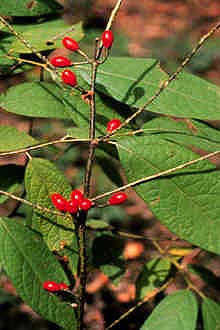Lindera
| Lindera | |
|---|---|

| |
| Lindera melissifolia | |
| Scientific classification | |
| Kingdom: | Plantae |
| Clade: | Tracheophytes |
| Clade: | Angiosperms |
| Clade: | Magnoliids |
| Order: | Laurales |
| Family: | Lauraceae |
| Genus: | Lindera Thunb.
|
| Species | |
|
See text | |
| Synonyms | |
Lindera is a genus of about 80–100[1] species of flowering plants in the family Lauraceae, mostly native to eastern Asia but with three species in eastern North America.[1][2] The species are shrubs and small trees;[2] common names include spicewood, spicebush, and Benjamin bush.
Name
The Latin name Lindera commemorates the Swedish doctor Johan Linder (1676-1724).[3]
Description

Lindera are
Ecology
The genus appears to be able to occupy widely different habitats as long as its requirements for water are met.[citation needed] Habitat fragmentation severely affects dioecious[citation needed] species like Lindera melissifolia (pondberry), because populations with plants of a single sex can only vegetatively reproduce. With significant habitat loss, plants become ever more isolated, lessening the likelihood that pollinators will travel from male to female plants.
Most are found on the bottoms and edges of shallow seasonal ponds in old dune fields, but in drier areas they occur in low riverine habitat.[citation needed] Most Lindera colonies occur in light shade beneath a forest canopy, but a few grow in almost full sunlight.[citation needed] In warmer areas they occur in bottomland hardwood forests.[citation needed]
The North American species of Lindera are relicts that originally were more common when the climate of North America was more humid, and they are not so widespread geographically as in the past.
The hermit thrush has been identified as a dispersal agent of seeds of L. melissifolia.[4]
Lindera species are used as food plants by the
Selected species
Uses
The bark, twigs, and leaves of some species can be used to make tea. The berries have also sometimes been used. The young bark can be chewed to parch thirst.[5]
Lindera umbellata contains linderatin, methyllinderatin and linderachalcone which are structurally related to cannabidiol.[6][verification needed]
References
- ^ a b 1. Lindera Thunberg, Flora of North America
- ^ a b c d e 5. Lindera Thunberg, Flora of China
- ISBN 978-1-60469-196-2.
- S2CID 3694410.
- OCLC 799792.
- S2CID 84302225.
